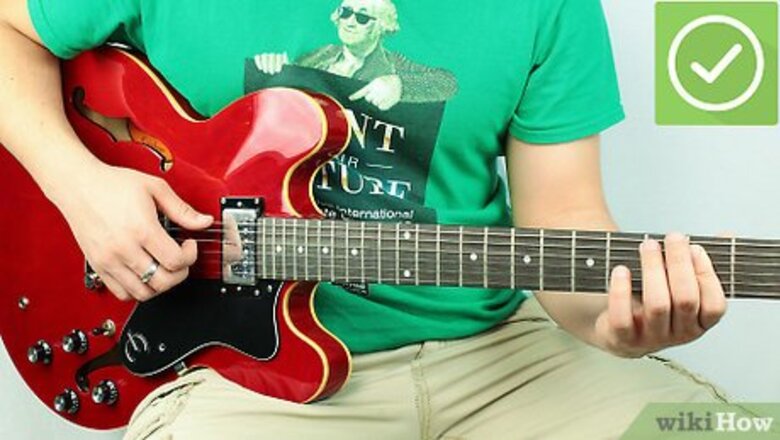
views
Getting Comfortable
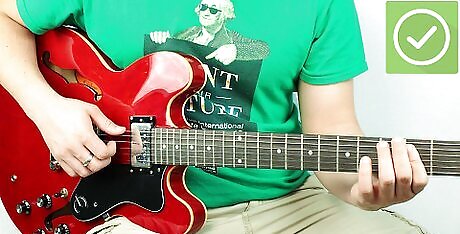
Hold the guitar correctly. If you're right handed, hold the guitar so your right hand falls about halfway between the sound hole and the bridge of the guitar, and support the neck of the guitar with your left hand. With the guitar tight in to your body, orient the guitar so the the smallest string is pointed toward the ground and the thickest string toward the ceiling. Hold the back of the guitar so it touches your stomach and chest and rests on the leg of your strumming/picking hand. The neck should be aimed up, at about a 45 degree angle. With your left hand, hold the neck in the V created by your thumb and forefinger. You should be able to smoothly move your left hand up and down the neck without having to hold it up, letting your leg and your right elbow cradle the guitar comfortably. If you're having to use your left hand to support the guitar up, you're holding the guitar incorrectly. Find a comfortable chair that allows you to hold and play your guitar properly. Stools, benches, or other hard-backed chairs are appropriate, anything that will force you to sit straight-backed with good posture is good. Cushioned stools made specifically for guitar playing are common at guitar shops, which you might peruse if you're interested, but regular kitchen chairs are appropriate as well. Try not to use a chair that has arms.
Tune your guitar. Start every practice session by tuning your guitar. Playing an out-of-tune guitar can make practice sessions frustrating and counterproductive, making it important that you learn how to tune your guitar yourself as soon as possible. The ability to get your guitar in tune quickly will make practicing a lot smoother and more fun. To tune with an electric tuner, hold the tuner close to the sound hole of an acoustic guitar, or plug an electric guitar directly into the tuner with quarter-inch cable. The tuner will indicate whether or not each string is flat (too low) or sharp (too high), and you can turn the corresponding tuning peg until the tone is correct. On many electric tuners, the light will turn green when the tone is correct. To tune the guitar to itself, hold the low E string at the fifth fret to play an A, which should match to the 5th string. Tune the A string until the tones match, then hold the A string at the fifth fret and do the same thing with the D string. The only variation is the G string, which you'll hold at the 4th fret to match to the B string. This might not get you in perfect pitch, but it's fine for practice, as long as the guitar is tuned relative to itself. Free online tuners, are also available to produce the proper tones and match them. Visit a free online tuner by clicking here.

Hold the guitar pick correctly. The pick, also called the plectrum, can be a source of frustration for beginning players. To make sure you build the right skills and comfortability with your instrument, you need to practice holding the pick correctly. To hold the pick correctly, turn your picking hand (your dominant, or writing hand) with your palm parallel to your stomach. Curl all your fingers in toward your palm and place the pick with the skinny point facing directly at you on top of your pointer finger. Hold it in place with your thumb. There should be no more than about two centimeters of pick sticking out of your hand. Holding the pick at the end will result in lots of drops and bad habits. To learn to pick and strum correctly, hold the pick with very little sticking out.
Practicing Fundamentals
Practice playing chords. Practice forming chords properly and playing clean chords, without striking any dead strings. Practice chords until each note rings out evenly, no louder or quieter than any other note in the chord. Practice switching between chords to make your transitions as smooth and as fluid as possible. Start by forming first-position chords. First-position chords are played between the first and third fret, generally incorporating a lot of open strings. You can play most pop, country, and rock songs on a few basic first-position chords. Common first-position chords for beginners to learn include the G chord, D chord, C chord, E chord, A chord, and F chord.

Practice forming barre chords. Barre chords, also called power chords, are all made from the same finger-positioning at different frets on the guitar. You can form a G chord in first position, or by forming a barre chord at the third fret, for example. They tend to be somewhat difficult for the beginner, because they require a wide fingering, but are great for playing rock and punk songs.
Always practice to a beat. One of the most commonly overlooked and essential things to becoming a good guitar player is to play in time. It's great if you can play the solo from "Black Dog" at a million miles an hour, but can you play it slowly, with feeling? Practicing to a beat forces you to play the notes you see, not the notes you can play. Developing a sense of rhythm in your playing will make you a better guitar player.
Practice scales. If you're taking lessons, you'll likely be provided with scale sheets, while if you're learning from a book it'll be up to you to find the scales and practice them yourself. Mel Bay books and other resources have been teaching guitar players to pick for decades, while online sheet music and exercises are also available. The pentatonic scale is a common rock key for guitar players to learn. Made up of five notes in each scale, the pentatonic scale, also often called "the blues scale" is the basis for many different types of music. Practice it in each key. Learning different scales and modes is a great way of improving your playing, allowing you to maneuver around the guitar, but it's not the most fun exercise. Take a scale and attempt to turn it into a guitar solo. To make scales more fun, try to make them swing, playing them at different tempos, once you've got the basics down.
Learn some songs to make practicing more fun. Pick a few songs that you'd like to learn and start picking out the different parts, with the aid of sheet music, tablature, or listening by ear. try to learn songs all the way through, not just a single lick or chord progression. Practice chaining together the different parts of a song to get all the way through, and you'll be teaching yourself about composition and learn to play with stamina. It's harder than it looks. For the beginner, folk and country songs are often the easiest to learn. Try to play the chords to "Folsom Prison Blues" by Johnny Cash, which is a fun and easy place to start. Other popular beginner songs that are good to practice include "Tom Dooley," "Long Black Veil," or even "Mary Had a Little Lamb." Pick a simple children's song to learn. It's likely it won't involve more than three chords: G, C, and D major. For the intermediate player, start picking songs that introduce uncommon chords or unusual rhythm playing to learn more complex styles. Try learning songs that are outside of your listening range, to force yourself into unexplored regions. If you like classical, try learning "Lithium" by Nirvana, for it's surprisingly complex chord voicing and melodic structure. Rock players might try to learn "Fur Elise" by Beethoven, to learn a new style. All players should learn to play all of "Stairway to Heaven," so you can say you've arrived as a guitar player. For the advanced player, choose compositionally difficult material that with force you to learn new techniques in your desired genre of music. Metal players should master the complex harmonics of Opeth leads, while country players should study Merle Travis's patented picking style, and rock players could spend a lifetime dissecting Jerry Garcia's psychedelic explorations. Taylor Swift Taylor Swift, Singer & Businesswoman Practice diligently to improve your skills. "I have to practice to be good at guitar. I have to write 100 songs before I write the first good one."
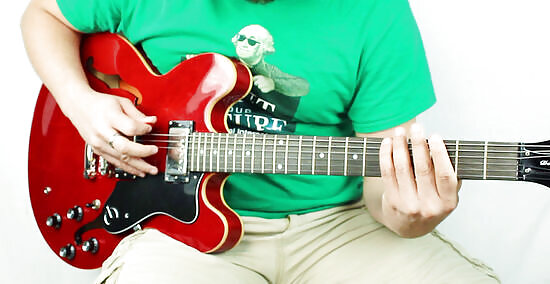
Make fundamentals fun. Strike a deal with yourself: learn a new song, or riff, for every new scale you tackle, or page of your practice book you pass during lessons. It's also a good idea to talk to your teacher, if you have one, about songs that you'd like to learn, so you don't spend all your time mastering Nirvana songs you don't have any interest in learning. Most guitar teachers are happy to teach you what you want to learn.

Use your ears and your eyes. Many of the greatest guitar players learned to play by listening repeatedly to the same song over and over again, their ear to the radio, slowly picking out the different parts on their own. Learning to play by ear is an equally-effective and important way of learning to play guitar. Listen to your favorite tunes until you can pick up the tricks and techniques the guitar players are using.
Developing a Routine

Practice for at least 20-40 minutes. To build up your guitar playing stamina and to retain the muscle memory that you're working to build, you need to practice somewhere in the neighborhood of 30 minutes a day. As you become more proficient and build callouses on your fingers that'll make playing more comfortable, you'll be able to practice more in a day, but in the beginning it's good to aim for a happy medium. 30 minutes is long enough to improve and work on a considerable amount of material, but not so long as to wear you out.
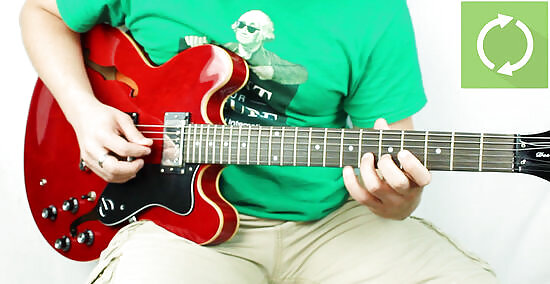
Practice at least 5 times a week. Because building callouses and dexterity is such an important part of playing guitar, it's very important to practice consistently, several times a week, or you'll end up back at square one every time you pick up the instrument. Try setting a practice time each day, maybe right after you get done with work or school, or right after dinner. Start making it a habit to pick up the guitar at that same time every day and putting in your 30 or 40 minutes. If you rarely practice guitar, that will lead to pain in the finger tips all over again. It will be so much easier to play guitar if you practice a lot because of no pain in your finger tips and because you will be used to playing and reading notes and tablature.
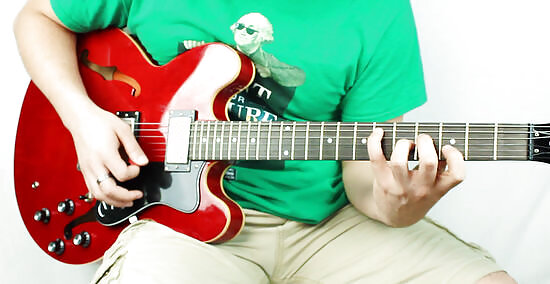
Start your session with regular warm-ups. Each time you pick up the guitar, sit in your practice chair, holding the guitar and the pick correctly, and do some exercises for at least 3 or 5 minutes to get your fingers warmed up for your session. Picking even quarter-notes on each of the first four frets of each string, from low E to high E is a common warm-up exercise. Common warm up exercises usually involve picking a particular pattern up and down the neck of the guitar, not necessarily the most tuneful pattern, but one that'll get your fingers loose. You can develop your own or learn one from a guitar teacher you like. Anything repetitive can be appropriate for a warm-up. Running up and down a new scale you're learning, or playing your favorite Clapton lick. Whatever you like to play, play it up and down a few times until your fingers feel loose and comfortable. Then you're ready for practice.
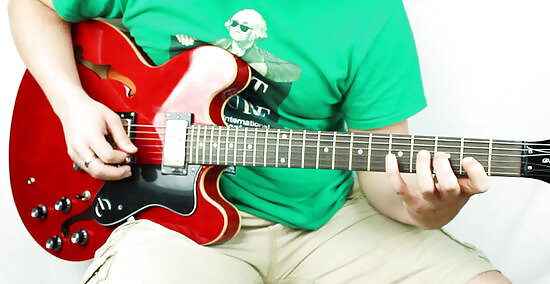
Balance skill-building with fun exercises. In each practice session, it's important to give equal weight to the things you want to do and the things you have to do. Want to practice the "Smells Like Teen Spirit" solo? Go for it, but make yourself earn it by running through your scale sheet first. Weight the latter half of each practice session with fun activities to give yourself something to look forward to.
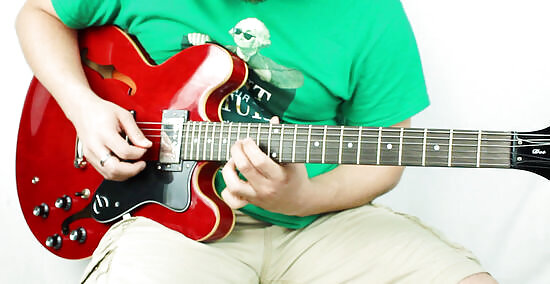
Always keep moving forward and challenging yourself. It's possible to reach plateaus in your guitar-playing ability and start to level off. In fact, many guitar players aren't much better after five years of playing than after the first five months, because of these plateaus. To practice effectively, you need to learn to embrace the challenge of learning a new song, mastering a new style, or adding complexity to the skills you've already learned, so you can avoid the flat-line. Nailed the solo from "Black Dog" by Zeppelin? Write a new one in mixolydian mode, or try to play it backwards. Play the whole solo without ever playing the root note. Give yourself little challenges to force yourself to improvise and improve.
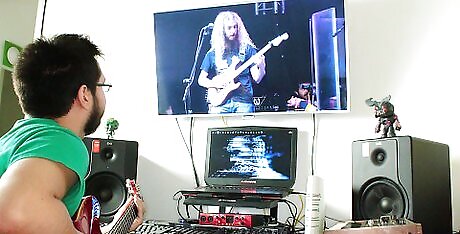
Practice with and learn from other players. It's very difficult to learn an instrument completely on your own. While it's not necessarily critical to pay for private lessons, there's no substitute from playing with other people and learning things first hand. It's an excellent way to practice. Look for open jam sessions in your town, at which you can hang out and learn the tricks of the trade from more experienced players. You might even get a band out of it. Embrace YouTube tutorials. Learning to play guitar has never been easier, since we've got the ability to see close-up footage of long-dead greats like Mississippi John Hurt, or Rev. Gary Davis picking their compositions close up. Where guitar players once had to listen, not you can see where the fingers of the great ones went, and learn from their styles.
Staying in Guitar Shape

Manage the finger pain. One of the toughest parts of practice and learning to stick with the guitar is the finger pain in your fretting hand. Pushing on the steel or nylon strings is painful at first, no doubt about it, and it'll take a while of negotiating that pain before you build up callouses that'll make it more comfortable. Practice more, but for shorter sessions, if the pain is too strong. If you find yourself unable to play for 30 or 40 minutes without uncomfortable finger pain, take a break until your fingers feel better. Shake your wrist and move it around to increase the blood flow and give your finger tips a break.
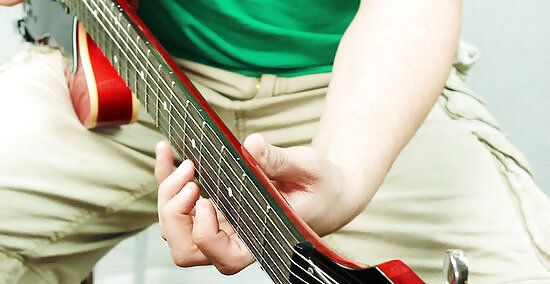
Make sure you're not pushing the strings too hard. You can make sure you're not pushing the strings too hard, causing unnecessary pain, by finding the string's "buzz point." Push on a string like you normally do, then gradually let up on the string as you pick it. Find the point at which the string starts playing dead, or buzzing, because you're not pushing it hard enough. The best pressure to use is just past the buzz point, light enough to be comfortable, but hard enough to avoid the buzz.

Stretch your arms, back, and hands before and after practice. No, guitar playing may not be a sport, but stretching out your arms and your back quickly before and after your practice sessions can make you a lot more comfortable. To stretch your hands, wiggle your fingers, waving your fingers like seaweed fluttering in the water. It's also a good idea to do some quick finger push-ups, pressing into the top of a desk or table with your fingertips, then letting your hand fall and push it back up. To stretch your arms and shoulders, wrap each arm around your chest, one at a time, as if you were giving yourself a hug. With the other arm, pull gently but firmly on your elbow to loosen the muscles in your arms and shoulders. Do this with each arm for a slow count of 15. To stretch out your back, reach your arms up toward the sky as high as you can for a count of 15, then hold a push-up position, as straight as possible, for another 15. You're ready to practice.

Breathe. Holding your breath is especially common when you start playing on stage, or performing in front of a teacher or other listener. It can even happen when you practice, creating tightness in your upper chest and giving you a tendency to play irregularly and rush through your phrases. Practice with as light a grip on your instrument as possible, and breathe comfortably and deeply, especially when you're concentrating. If and when you notice yourself holding your breath, stop for a second and reposition yourself. Make sure you're sitting upright and take a few deep breaths before continuing. Especially if you're getting frustrated trying to practice a particular song or scale, give yourself a breath. It can make a big difference.
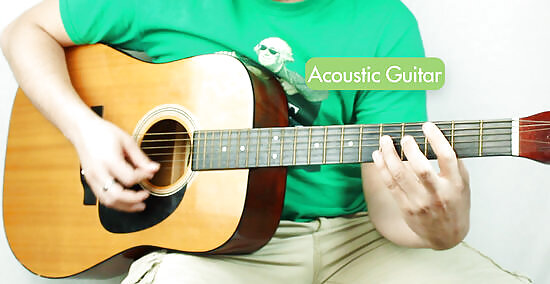
Ease into a new instrument or style. Whether you're trying out your first jazz chords, switching from an electric to a classical acoustic guitar, or trying to speed up your finger exercises, it's important to start slow, learn the part correctly, and allow yourself the time to acclimate to the new way of playing. Since guitars have all different variety of neck sizes, string sizes, and fret gaps, it's important to alter your practice sessions with a new instrument slightly. It might not be possible for you to play particular songs or scales as quickly as you once did. Give yourself the time to acclimate to the new instrument, and give your fingers a chance to stretch in the new ways. You've got to retrain your muscle memory, if the frets are just a little different.
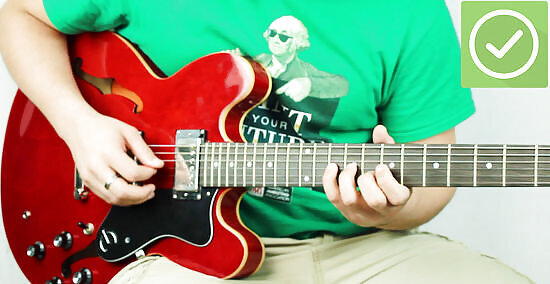
Always start new exercises slow and then speed them up. A popular guitar players adage goes, "Those who can't play well play fast. Those who can't play fast play loud." Point being, don't develop a bad habit of rushing through each lick to prove how fast you can shred. The best guitar players aren't the fastest guitar players, they're the once who play correctly. Learn to practice in time, then speed up to increase your dexterity when you've got it down.




















Comments
0 comment